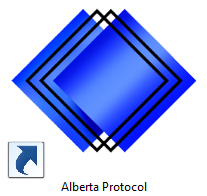|
|
Starting the a protocol form the shortcut:
The protocols shortcut will start sliceOmatic with 2 command line arguments: -s "directory" -n "protocol name"
Having the "-s" command line argument set the following system variables: •$INTERFACE_FLAG will be set to 3, meaning the simplified menus and the associated help pages are on. •$INTERFACE_ROOT will be set to the directory containing the protocol's scripts, meaning that the simplified menus will be associated with the script files found in the target sub-directory of the installation directory.
Having the "-n" command line argument set the following system variables: •$INTERFACE_NAME will be set to the name of the protocol, meaning the name of the new group of buttons in the Mode menu will be "protocol name".
|
|
|
|
Starting a Protocol" from the configuration interface:
|
|
•You can enable/disable the new menu group with the "Show simplified menus?" choice.
•The sub-directory containing the protocol's script is specified with the "Menu's dir" line.
•The name of the new menu group is given by the "Menu's name" line.
•You can enable/disable the new menu group with the "Display help page?" choice.
If you save the configuration, then the "sliceOmatic_ini.scp" will contain the matching commands in the "Menu" section.
|
|
The "sliceO_ini.scp" configuration file:
interface: flag value Where value is a bit flag, with bit 0x01 controlling the presence of the simplified menu, and bit 0x02 the opening of the help page associated with each buttons.
interface: name menu_name Where "menu name" is the name associated with the new mode group. This name will be copied to the $INTERFACE_NAME variable
interface: root dir_name Where "dir_name" is the directory containing the scripts associated with the new menu buttons. This directory's name will be copied to the $INTERFACE_ROOT variable. |
|
The "step_x" scripts:
The $INTERFACE_ROOT directory contain the script files that will be used in the simplified interface. These scripts are named "step_x.scp", with x going from 1 to n. There will be 1 menu button per consecutive step script in the directory, starting with step 1.
Each of these scripts will pre-set the program's interface to help the user in the task specific to that step.
There are 2 commands in these scripts that are unique only to the simplified menu interface: The "name" and the "html" commands.
•The "name" command give the name of the button (this will be appended to the "step_x" name). for example, if step_1.scp contain the command "name: "Read the files"", then the first button of the new mode group will be called "step 1: Read the files".
•The "html" command give the address of a web page associated with the button. If the configuration parameter "Display help page?" has not been set to off, the associated web page will be open once when each menu button is pressed.
The Step_0.scp script is a special case. It is not associated with a button in the Modes menu, instead it is executed at startup.


